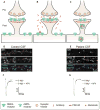Mechanisms underlying autoimmune synaptic encephalitis leading to disorders of memory, behavior and cognition: insights from molecular, cellular and synaptic studies
- PMID: 20646055
- PMCID: PMC2955837
- DOI: 10.1111/j.1460-9568.2010.07349.x
Mechanisms underlying autoimmune synaptic encephalitis leading to disorders of memory, behavior and cognition: insights from molecular, cellular and synaptic studies
Abstract
Recently, several novel, potentially lethal and treatment-responsive syndromes that affect hippocampal and cortical function have been shown to be associated with auto-antibodies against synaptic antigens, notably glutamate or GABA-B receptors. Patients with these auto-antibodies, sometimes associated with teratomas and other neoplasms, present with psychiatric symptoms, seizures, memory deficits and decreased levels of consciousness. These symptoms often improve dramatically after immunotherapy or tumor resection. Here we review studies of the cellular and synaptic effects of these antibodies in hippocampal neurons in vitro and preliminary work in rodent models. Our work suggests that patient antibodies lead to rapid and reversible removal of neurotransmitter receptors from synaptic sites, leading to changes in synaptic and circuit function that in turn are likely to lead to behavioral deficits. We also discuss several of the many questions raised by these and related disorders. Determining the mechanisms underlying these novel anti-neurotransmitter receptor encephalopathies will provide insights into the cellular and synaptic bases of the memory and cognitive deficits that are hallmarks of these disorders, and potentially suggest avenues for therapeutic intervention.
© The Authors (2010). Journal Compilation © Federation of European Neuroscience Societies and Blackwell Publishing Ltd.
Figures


References
-
- Alios B. Association between campylobacter infection and Guillain-Barré syndrome. The Journal of Infectious Diseases. 1997;176:S125–S128. - PubMed
-
- Ang CW, Jacobs BC, Laman JD. The Guillain-Barré syndrome: a true case of molecular mimicry. Trends Immunol. 2004;25:61–66. - PubMed
-
- Armstrong N, Gouaux E. Mechanisms for activation and antagonism of an AMPA-sensitive glutamate receptor: crystal structures of the GluR2 ligand binding core. Neuron. 2000;28:165–181. - PubMed
-
- Bataller L, Dalmau JO. Paraneoplastic disorders of the central nervous system: update on diagnostic criteria and treatment. Semin Neurol. 2004;24:461–471. - PubMed
Publication types
MeSH terms
Substances
Grants and funding
LinkOut - more resources
Full Text Sources
Medical

